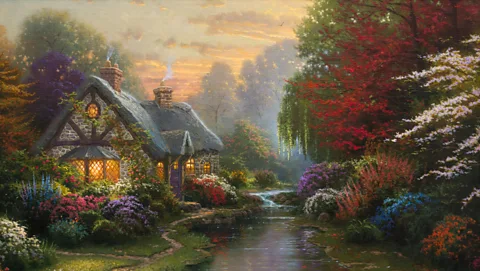
Beloved by many, despised by others, Thomas Kinkade’s quaint rustic scenes and his wholesome image belied a dark and tortured story that contrasts with his ‘sugary’ artworks.
Thomas Kinkade was one of the best-selling artists in history, as well as one of the most divisive. When he died in 2012, the American painter had been rocked by business problems, but at his commercial peak a decade earlier, his company was bringing in more than $100m a year. And yet his work was despised by many critics – not because it was blasphemous or obscene, but because, well, he specialised in quaint pictures of thatched-roof rural cottages nestling in leafy groves. “Thomas Kinkade’s style is illustrative saccharine fantasy rather than art with which you can connect at any meaningful level,” Charlotte Mullins, the author of A Little History of Art, tells the BBC. “It is schmaltzy pastiches of Disney-style woodland scenes, complete with cutesy animals and fairy tale cottages. They are… like the images you find on cheap greetings cards – sugary and forgettable.” And compared to some critics, Mullins is being polite.
These critics don’t just consider Kinkade’s paintings to be nauseatingly sickly, they detect something disturbing and ominous about them. In her 2003 book on California, Where I Was From, Joan Didion summed up his art by saying. “It typically featured a cottage or a house of such insistent cosiness as to seem actually sinister, suggestive of a trap designed to attract Hansel and Gretel. Every window was lit, to lurid effect, as if the interior of the structure might be on fire.” As harsh as that sounds, Didion may have been more perceptive than she realised. Art for Everybody, a new documentary directed by Miranda Yousef, shows that the man who called himself the “Painter of Light” did indeed have a dark side. “His branding was so effective that you didn’t know there was this really complicated and I would say tortured artist behind it all,” Yousef tells the BBC. “He lived a Greek tragedy of a life.”
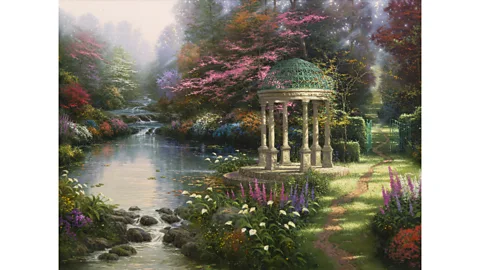 The Kinkade Family Foundation
The Kinkade Family FoundationThe documentary features audio tapes recorded by Kinkade when he was a long-haired, bohemian-looking art student in California in the 1970s – and even then, he was already fretting over the question of whether he could make an impact as an artist while making a decent living. After a stint in Hollywood, painting backgrounds for Ralph Bakshi’s 1983 animated feature film, Fire and Ice, he concentrated on idealised, nostalgic American landscapes, and he and his wife Nanette sold reproductions of them outside a local grocer’s shop. In the 1990s, he took the idealism and the nostalgia to new heights, and swapped his rugged vistas for soft-focus pastoral scenes that a Hobbit might deem a bit on the twee side. Old-fashioned lampposts and cottage windows glowed. Streams twinkled beneath slender stone footbridges. Bushes burst with pastel flowers. And cash registers rang. Kinkade didn’t sell the paintings themselves, but the hazy idylls they depicted were soon being printed on collectible plates advertised in newspapers and magazines. For many Americans, they were comforting refuges from the modern world.
In Art for Everybody, Christopher Knight, the art critic of the Los Angeles Times, is contemptuous of Kinkade’s imagery. “It’s a cliché piled upon a fantasy piled upon a bad idea,” he says. “The colour is juiced and the light coming from inside those cottages is intense and blaring.” Just as importantly, as far as his critics were concerned, Kinkade’s pictures had nothing to them beyond their superficial decorative qualities. “They are banal and hollow, with no intent to say anything meaningful,” says Mullins. “Today we would think they had been produced by AI – designed as if by algorithm to a certain formula.” But Yousef insists that Kinkade’s skill can’t be discounted. “There were actually other people who were painting cottages and Christmas scenes and putting them on plates and all that stuff,” she notes, “and the thing is that Kinkade’s were so much better. His works just blew everybody else’s out of the water.”
She also believes that Kinkade’s paintings, rather than being wholly market-led, were linked to his childhood in Placerville, California, where he was raised by his single mother and only intermittently saw his violent father. “It’s a common criticism that his cottages look like they’re on fire on the inside. And then you learn that it was because when he was growing up it was always cold and dark in the house when he got home, because they didn’t have the money to keep the heat and the lights on. He was painting the thing that he wanted.”
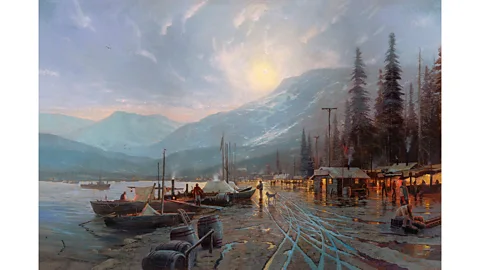 The Kinkade Family Foundation
The Kinkade Family FoundationKinkade’s deprived upbringing, says Yousef, didn’t just inspire his choice of subject matter, but drove him to make as much money as he could. He and his business partners printed pictures on an industrial scale, as well as putting his immediately recognisable imagery on furniture and ornaments, and selling them on the QVC shopping network. They also set up hundreds of faux olde worlde Thomas Kinkade Signature Galleries in shopping malls around the US, and trademarked the “Painter of Light” brand. Again, Yousef doesn’t see Kinkade as entirely calculating. Having grown up in a house with no pictures on the walls, “He sincerely believed that art should be accessible to everyone.”
Behind the fantasy
Whatever you thought of the paintings, the mass-marketing of the work of a single artist was certainly groundbreaking. In interviews at the time, Kinkade asserted that he was no different from an author selling stacks of novels or a musician selling CDs. He even declared that by industrialising his output, he was doing what Andy Warhol had always dreamt of. But Mullins argues that Kinkade was being “obfuscatory and disingenuous” by churning out reproductions by the thousand, paying his assistants to add a few dabs of paint here and there, and then selling these prints for thousands of dollars, as if they were rare and precious works of art. “Prints offer an affordable way of buying art by great artists,” she says. “They retain their value through the limited nature of the edition. This was never Kinkade’s strategy.”
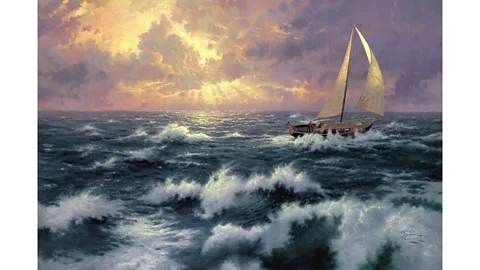 The Kinkade Family Foundation
The Kinkade Family FoundationStill, this sort of disagreement between Kinkade and his critics was one of his selling points. Art for Everybody features news reports and promotional videos, in which he tells adoring audiences that his art could be understood and appreciated by everyone, whereas only the snooty elite could see anything artistic about Chris Ofili putting elephant dung on his canvases, or Tracey Emin presenting her unmade bed to gallery-goers. “This is not legitimate art,” he proclaimed. As much a televangelist as a painter, Kinkade was a born-again Christian who assured his devotees that buying his work put them on the right side of a political and spiritual line separating them from decadent metropolitan tastemakers. He trademarked the sobriquet “Painter of Light”, not just because of all the sunlit clouds and fiery cottages in his pictures, but to signify that he was a force for virtue and Christianity. “The art world is a world of darkness today,” he thundered. He, in contrast, was “someone who stands up for family and God and country and beauty”. A doughy, plaid shirt-wearing fellow with a thick moustache, he often appeared on television with his blonde wife and his four blonde daughters: the embodiment of wholesome, traditional, all-American values. His fans weren’t just paying for his pictures; they were paying to associate themselves with this proudly conservative persona.
But that persona, like the pictures themselves, was more a fantasy that Kinkade wished for than an accurate representation of reality. He was prone to swearing after the directors of his mawkishvideos called “cut”. He relied on alcohol to cope with work pressures. And, in the documentary, his daughters say that they were encouraged to smile in videos and personal appearances, but often felt as if their father cared more about his career than about them. “Thomas Kinkade and his persona and his brand really cast an extraordinarily long, dark shadow over his entire family,” says Yousef, “and there was a lot wrapped up in perpetuating the brand and preserving it.”
In order to maintain this brand and the vast business empire that went with it, Kinkade had to present himself as a Christian paragon, and he had to complete a stylistically identical painting every month. That meant that he had to suppress other, more conflicted parts of his psyche. The strain became too much. In the mid-2000s, Kinkade fell out with his business partners, and had legal battles with gallery franchisees. He reinvented himself as a womanising, hard-drinking hellraiser. After some interventions by his friends and family, some time in rehab, and the collapse of his marriage, he died of an accidental overdose of alcohol and diazepam at the age of 54.
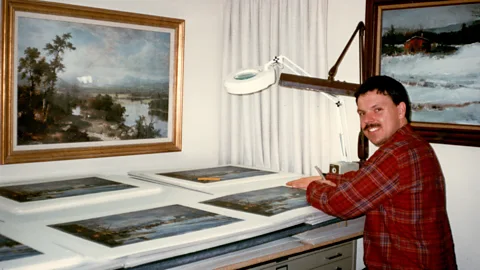 Art for Everybody
Art for EverybodyIt was only after his death that his family sorted through the vault containing his artwork, and uncovered a stash of bleak, violent drawings and paintings that seemed to express his inner rage and fear in a way that his cottage paintings never could: a shack in the middle of nowhere on a murky night; a nun pointing a gun at herself; giant monsters and distorted faces. Art for Everybody raises the questions of whether these pictures are more authentic than the ones the public knew about. Do they express how Kinkade really felt about his difficult upbringing and his frightening father? Would it have been healthier for him to explore the shadowy netherworlds in these pictures instead of shutting himself inside his stifling sylvan cottages, year after year? And were his critics right to say that his famous paintings were disturbing all along? “One of the things that was obvious early on,” says Yousef, “was that his fans had a two-dimensional view of him and his critics had another completely different two-dimensional view of him. I knew there was a three-dimensional person in there somewhere, and that’s what I wanted to try to find.”
In some ways, Kinkade was ahead of his time. First, he was a culture warrior before culture wars were being fought as fiercely as they are now. As someone who claimed that he was taking a stand for Christianity and patriotism and against the intellectual elite, he was staking out territory occupied by more and more in the US today. He was also ahead of his time as an artist with such a brazen commercial side. “Today we’re seeing all these artist collabs,” says Yousef. “There’s Yayoi Kusama who’s working with Louis Vuitton, and Tom Sachs is working with Nike, and Kehinde Wiley is doing a collab with American Express, whereas you see in the movie an MBNA bank card with a Thomas Kinkade painting on it. He was already doing it 20 or 30 years ago.”
Finally, by calling himself the Painter of Light, and by trading on his pious family-man persona, Kinkade turned himself into a kind of product. “Look at where we are today with social media, and everybody being a brand,” says Yousef. “He was really ahead of his time with that. But I think that one of the big questions of the film is, what are the costs of turning yourself into a brand?” In Kinkade’s case, the costs were unbearably high.
Art for Everybody is released on 28 March in the US.


